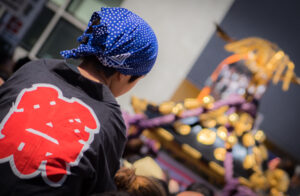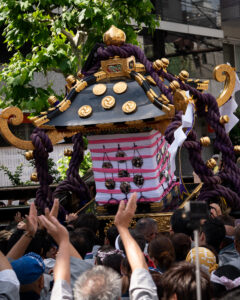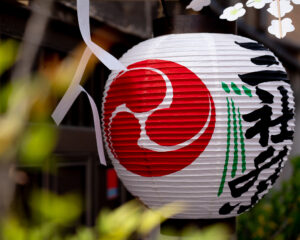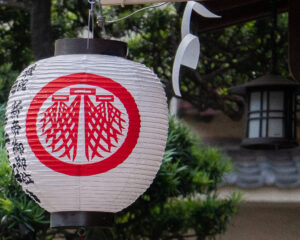“San-ja Matsuri”, one of the three most magnificent shrine festivals held in Tokyo was a topic of my blog issued on May 19, 2019 (LINK: 2019 San-ja Matsuri ). The festival for 2020 was originally scheduled from May 15 to May 17 but it has been put off to October upon due efforts to put the Wuhan virus under control. Although I cannot provide you with fresh photos of San-ja Matsuri for this year, I like to invite you to a world of “Matsuri” by referring to what are meant by tools and items used in the festival so that you’d be able to enjoy San-ja Matsuri in October with more insights. Let’s stay home and safe for now but I wish you’d be able to plan to visit Japan in Oct.

What is the object on the top of “Mikoshi”?
“San-ja Matsuri” literally means “festival (Matsuri)” for “three deities (San-ja)” who are enshrined at the Asakusa Shrine in Tokyo. During the festival, each of the three deities temporarily moves on to “Mikoshi” (a potable shrine) and three separate groups of local people are holding their responsible “Mikoshi” on shoulders, marching through their towns. People believe that the more lively the Mikoshi procession goes, the higher the power of the deities becomes, thus the more divine help falls onto their town. This is why they rock “Mikoshi” back and forth vigorously.


Please pay attention to an object on the top of the Mikoshi’s roof in two photos (above). You will find a bird-shaped object (left, or upper) and a sphere (right, or lower). The bird-shaped object is called “Hou-oh” or a phoenix which is an imaginary creature with a long life of over 500 years. When the time comes, Hou-oh puts itself into a fire and regenerates from the ashes. So Hou-oh is a symbol of longevity and renewal. The sphere is called “Hou-ju” or a precious orb. Hou-ju is believed to have a magical power to ward off misfortune and fulfill people’s wishes. Hou-ju is a common auspicious item in both Shintoism and Buddhism. There seems no fixed theory about which object, Hou-oh or Hou-ju, should be used for Mikoshi but it is believed that Mikoshi with Hou-ju has a longer history than that with Hou-oh: the latter became popular in the Edo period (17~19th century).
What are round metal objects attached on Mikoko’s body?
A round ornament is actually a mirror. A mirror is usually placed in a main hall of a Shinto shrine as “Yori-shiro”. Yorishiro is a Shinto object to which a Shinto deity is drawn, being of representative of its spirit. As a symbol of Shintoism, several mirrors are placed on a white cloth which raps the body of Mikoshi in order to protect the inside adornments against possible damage during the vigorous Mikoshi procession.
What do patters on lanterns represent?


During San-ja Matsuri, lanterns are being hung at the entrance of people’s houses around the Asakusa Shrine. They are made of “washi” or a traditional Japanese paper pasted onto bamboo rings. They are called “Chochin” and collapsible when unnecessary. On a lantern on the left, three designs are observed: they are, from the left, a red “Tomoe-mon (three comma-shaped design)”, a green simplified “Shime-nawa (straw rope)” and black three characters representing San-ja-matsuri. “Tomoe-mon” is an auspicious design for its symbolizing a flow of water, thus being a symbol of preventing a fire. “Shime-nawa” which is made of rice straw is a Shinto’s object to separate the sacred world from the ordinary world. A lantern on the left shows its other side, carrying a symbol of “San-ja (three Shinto deities)”. The design represents three fishing nets which remind people of the very original story about why local people started enshrining the three people as Shinto deities at the Asakusa Shrine. My blog dated May 9, 2019, brings you with a more story behind this (LINK: 2019 San-ja Matsuri ).
Actually, many other Shinto and traditional items can be seen in the festivals. I wish you’d be able to visit Japan in Oct, 2020, so that I or other partners of our LLP be able to guide you to Sanja Matsuri. Crossing fingers for the plague being expelled from the world as soon as possible.
By Jin Shibata

Comment